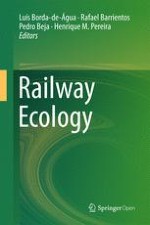Open Access 2017 | Open Access | Buch

Railway Ecology
herausgegeben von: Dr. Luís Borda-de-Água, Prof. Rafael Barrientos, Pedro Beja, Prof. Henrique Miguel Pereira
Open Access 2017 | Open Access | Buch

herausgegeben von: Dr. Luís Borda-de-Água, Prof. Rafael Barrientos, Pedro Beja, Prof. Henrique Miguel Pereira
This book is open access under a CC BY 4.0 license.
This book provides a unique overview of the impacts of railways on biodiversity, integrating the existing knowledge on the ecological effects of railways on wildlife, identifying major knowledge gaps and research directions and presenting the emerging field of railway ecology.
The book is divided into two major parts: Part one offers a general review of the major conceptual and theoretical principles of railway ecology. The chapters consider the impacts of railways on wildlife populations and concentrate on four major topics: mortality, barrier effects, species invasions and disturbances (ranging from noise to chemical pollution). Part two focuses on a number of case studies from Europe, Asia and North America written by an international group of experts.